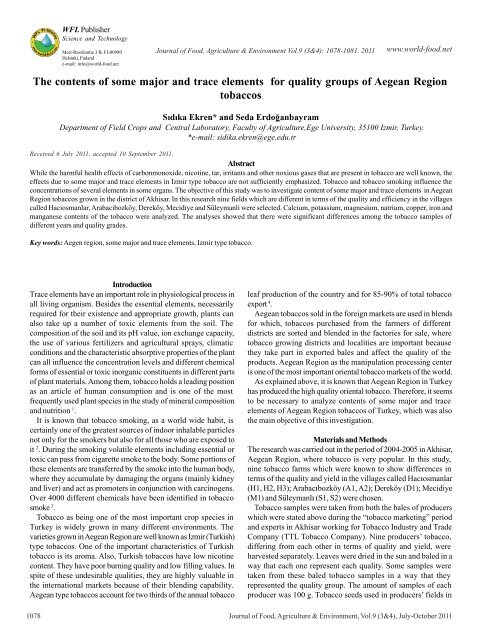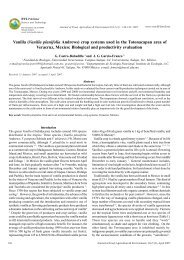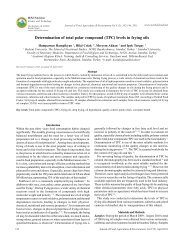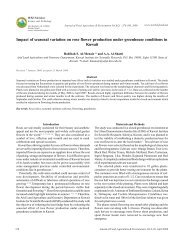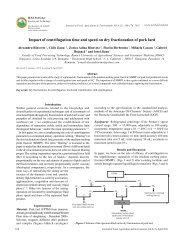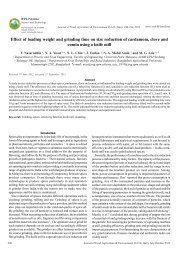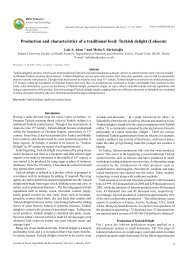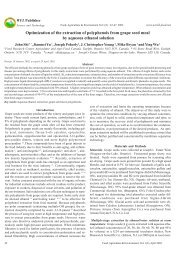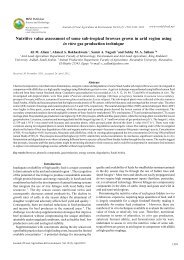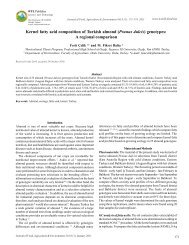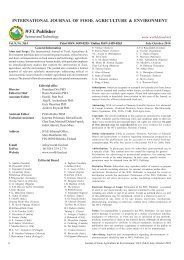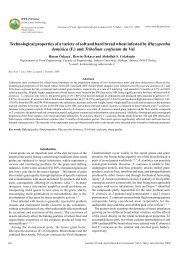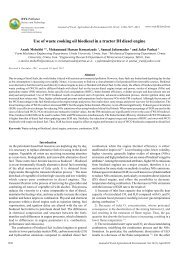The contents of some major and trace elements - World-food.net
The contents of some major and trace elements - World-food.net
The contents of some major and trace elements - World-food.net
Create successful ePaper yourself
Turn your PDF publications into a flip-book with our unique Google optimized e-Paper software.
WFL Publisher<br />
Science <strong>and</strong> Technology<br />
Meri-Rastilantie 3 B, FI-00980<br />
Helsinki, Finl<strong>and</strong><br />
e-mail: info@world-<strong>food</strong>.<strong>net</strong><br />
Journal <strong>of</strong> Food, Agriculture & Environment Vol.9 (3&4): 1078-1081. 2011<br />
www.world-<strong>food</strong>.<strong>net</strong><br />
<strong>The</strong> <strong>contents</strong> <strong>of</strong> <strong>some</strong> <strong>major</strong> <strong>and</strong> <strong>trace</strong> <strong>elements</strong> for quality groups <strong>of</strong> Aegean Region<br />
tobaccos<br />
Sıdıka Ekren* <strong>and</strong> Seda Erdoğanbayram<br />
Department <strong>of</strong> Field Crops <strong>and</strong> Central Laboratory, Faculty <strong>of</strong> Agriculture,Ege University, 35100 Izmir, Turkey.<br />
*e-mail: sidika.ekren@ege.edu.tr<br />
Received 6 July 2011, accepted 10 September 2011.<br />
Abstract<br />
While the harmful health effects <strong>of</strong> carbonmonoxide, nicotine, tar, irritants <strong>and</strong> other noxious gases that are present in tobacco are well known, the<br />
effects due to <strong>some</strong> <strong>major</strong> <strong>and</strong> <strong>trace</strong> <strong>elements</strong> in Izmir type tobacco are not sufficiently emphasized. Tobacco <strong>and</strong> tobacco smoking influence the<br />
concentrations <strong>of</strong> several <strong>elements</strong> in <strong>some</strong> organs. <strong>The</strong> objective <strong>of</strong> this study was to investigate content <strong>of</strong> <strong>some</strong> <strong>major</strong> <strong>and</strong> <strong>trace</strong> <strong>elements</strong> in Aegean<br />
Region tobaccos grown in the district <strong>of</strong> Akhisar. In this research nine fields which are different in terms <strong>of</strong> the quality <strong>and</strong> efficiency in the villages<br />
called Haciosmanlar, Arabacibozköy, Dereköy, Mecidiye <strong>and</strong> Süleymanli were selected. Calcium, potassium, magnesium, natrium, copper, iron <strong>and</strong><br />
manganese <strong>contents</strong> <strong>of</strong> the tobacco were analyzed. <strong>The</strong> analyses showed that there were significant differences among the tobacco samples <strong>of</strong><br />
different years <strong>and</strong> quality grades.<br />
Key words: Aegen region, <strong>some</strong> <strong>major</strong> <strong>and</strong> <strong>trace</strong> <strong>elements</strong>, Izmir type tobacco.<br />
Introduction<br />
Trace <strong>elements</strong> have an important role in physiological process in<br />
all living organism. Besides the essential <strong>elements</strong>, necessarily<br />
required for their existence <strong>and</strong> appropriate growth, plants can<br />
also take up a number <strong>of</strong> toxic <strong>elements</strong> from the soil. <strong>The</strong><br />
composition <strong>of</strong> the soil <strong>and</strong> its pH value, ion exchange capacity,<br />
the use <strong>of</strong> various fertilizers <strong>and</strong> agricultural sprays, climatic<br />
conditions <strong>and</strong> the characteristic absorptive properties <strong>of</strong> the plant<br />
can all influence the concentration levels <strong>and</strong> different chemical<br />
forms <strong>of</strong> essential or toxic inorganic constituents in different parts<br />
<strong>of</strong> plant materials. Among them, tobacco holds a leading position<br />
as an article <strong>of</strong> human consumption <strong>and</strong> is one <strong>of</strong> the most<br />
frequently used plant species in the study <strong>of</strong> mineral composition<br />
<strong>and</strong> nutrition 1 .<br />
It is known that tobacco smoking, as a world wide habit, is<br />
certainly one <strong>of</strong> the greatest sources <strong>of</strong> indoor inhalable particles<br />
not only for the smokers but also for all those who are exposed to<br />
it 2 . During the smoking volatile <strong>elements</strong> including essential or<br />
toxic can pass from cigarette smoke to the body. Some portions <strong>of</strong><br />
these <strong>elements</strong> are transferred by the smoke into the human body,<br />
where they accumulate by damaging the organs (mainly kidney<br />
<strong>and</strong> liver) <strong>and</strong> act as promoters in conjunction with carcinogens.<br />
Over 4000 different chemicals have been identified in tobacco<br />
smoke 3 .<br />
Tobacco as being one <strong>of</strong> the most important crop species in<br />
Turkey is widely grown in many different environments. <strong>The</strong><br />
varieties grown in Aegean Region are well known as Izmir (Turkish)<br />
type tobaccos. One <strong>of</strong> the important characteristics <strong>of</strong> Turkish<br />
tobacco is its aroma. Also, Turkish tobaccos have low nicotine<br />
content. <strong>The</strong>y have poor burning quality <strong>and</strong> low filling values. In<br />
spite <strong>of</strong> these undesirable qualities, they are highly valuable in<br />
the international markets because <strong>of</strong> their blending capability.<br />
Aegean type tobaccos account for two thirds <strong>of</strong> the annual tobacco<br />
leaf production <strong>of</strong> the country <strong>and</strong> for 85-90% <strong>of</strong> total tobacco<br />
export 4 .<br />
Aegean tobaccos sold in the foreign markets are used in blends<br />
for which, tobaccos purchased from the farmers <strong>of</strong> different<br />
districts are sorted <strong>and</strong> blended in the factories for sale, where<br />
tobacco growing districts <strong>and</strong> localities are important because<br />
they take part in exported bales <strong>and</strong> affect the quality <strong>of</strong> the<br />
products. Aegean Region as the manipulation processing center<br />
is one <strong>of</strong> the most important oriental tobacco markets <strong>of</strong> the world.<br />
As explained above, it is known that Aegean Region in Turkey<br />
has produced the high quality oriental tobacco. <strong>The</strong>refore, it seems<br />
to be necessary to analyze <strong>contents</strong> <strong>of</strong> <strong>some</strong> <strong>major</strong> <strong>and</strong> <strong>trace</strong><br />
<strong>elements</strong> <strong>of</strong> Aegean Region tobaccos <strong>of</strong> Turkey, which was also<br />
the main objective <strong>of</strong> this investigation.<br />
Materials <strong>and</strong> Methods<br />
<strong>The</strong> research was carried out in the period <strong>of</strong> 2004-2005 in Akhisar,<br />
Aegean Region, where tobacco is very popular. In this study,<br />
nine tobacco farms which were known to show differences in<br />
terms <strong>of</strong> the quality <strong>and</strong> yield in the villages called Hacıosmanlar<br />
(H1, H2, H3); Arabacıbozköy (A1, A2); Dereköy (D1); Mecidiye<br />
(M1) <strong>and</strong> Süleymanlı (S1, S2) were chosen.<br />
Tobacco samples were taken from both the bales <strong>of</strong> producers<br />
which were stated above during the “tobacco marketing” period<br />
<strong>and</strong> experts in Akhisar working for Tobacco Industry <strong>and</strong> Trade<br />
Company (TTL Tobacco Company). Nine producers’ tobacco,<br />
differing from each other in terms <strong>of</strong> quality <strong>and</strong> yield, were<br />
harvested separately. Leaves were dried in the sun <strong>and</strong> baled in a<br />
way that each one represent each quality. Some samples were<br />
taken from these baled tobacco samples in a way that they<br />
represented the quality group. <strong>The</strong> amount <strong>of</strong> samples <strong>of</strong> each<br />
producer was 100 g. Tobacco seeds used in producers’ fields in<br />
1078 Journal <strong>of</strong> Food, Agriculture & Environment, Vol.9 (3&4), July-October 2011
Akhisar belonged to Sarıbaglar tobacco type. In 2004, the first<br />
year <strong>of</strong> this study, 9 tobacco samples <strong>and</strong> in 2005, 9 samples as<br />
well, totally 18 tobacco samples in different quality groups were<br />
studied. Dried tobacco samples were digested with HNO 3 :HClO 4<br />
(4:1, v/v) <strong>and</strong> Ca, K, Mg, Na, Cu, Fe <strong>and</strong> Mn <strong>contents</strong> in the<br />
solutions were determined spectr<strong>of</strong>otometrically by using atomic<br />
absorbsion 5 .<br />
Statistical analyses: <strong>The</strong> data obtained from each component<br />
with 2 replications <strong>and</strong> 2 factors were subjected to statistical<br />
variance analyses (ANOVA) using F-test 6 . Variables in each<br />
component were subjected separately to variance analysis. <strong>The</strong><br />
means <strong>of</strong> the variables were grouped by using Least Significant<br />
Difference (LSD) values at 5% levels <strong>of</strong> probability.<br />
Results <strong>and</strong> Discussion<br />
It is well known that there are <strong>major</strong> <strong>and</strong> important differences<br />
among tobacco types. Within each type there are also wide<br />
differences among grades or stalk position (upper stalk, middle<br />
stalk <strong>and</strong> lower stalk position) <strong>and</strong> also one single leaf. For example,<br />
total nitrogen <strong>and</strong> total alkaloid content <strong>of</strong> the leaves are low in<br />
the center stalk position <strong>and</strong> high in both bottom <strong>and</strong> upper<br />
position 7 . <strong>The</strong> variations <strong>of</strong> the heavy metal <strong>contents</strong> are<br />
considered to be related to ge<strong>net</strong>ic characteristics, fertilizers,<br />
irrigation, climate, soil characteristics <strong>and</strong> also the storage<br />
conditions.<br />
Magnesium content: Magnesium is one <strong>of</strong> the important quality<br />
characteristics in tobacco leaves related with tobacco burning<br />
abilities. High ash content is usually associated with magnesium<br />
deficiency.<br />
<strong>The</strong> results <strong>of</strong> magnesium <strong>contents</strong> are presented in Table 1. In<br />
two years, magnesium <strong>contents</strong> in Aegean tobaccos were 0.13-<br />
0.64%. Results obtained showed that the highest magnesium<br />
content was recorded for S2 farms (0.64%) in the second year. On<br />
the other h<strong>and</strong> the lowest magnesium content was observed for<br />
H3 farms (0.13%) in the first year.<br />
<strong>The</strong> magnesium <strong>contents</strong> in the other studies were 0.29-1.41% 8 ,<br />
0.28-3.10% 9 <strong>and</strong> 0.282-0.920% 10 . In a similar study, the magnesium<br />
Table 1. Magnesium <strong>and</strong> potassium <strong>contents</strong> <strong>of</strong> Aegean Region<br />
tobaccos (%).<br />
Magnesium Potassium<br />
Farmers 2004 2005 Average 2004 2005 Average<br />
M1 0.51 a 0.53 ab 0.52 ab 1.94 cd 2.30 a 2.12 cd<br />
H1 0.53 a 0.24 e 0.39 c 1.08f 1.54 b 1.31 e<br />
H2 0.22 bcd 0.29 de 0.26 d 1.43 ef 1.33 b 1.38 e<br />
H3 0.13 d 0.20 e 0.16 e 1.11 f<br />
1.74 b 1.43 e<br />
S1 0.53 a 0.42 bc 0.47 b 2.29 bc 2.28 a 2.28 bcd<br />
S2 0.57 a 0.64 a 0.60 a 1.65 de 2.46 a 2.05 d<br />
A1 0.33 b 0.40 cd 0.37 c 2.43 ab 2.43 a 2.43 abc<br />
A2 0.25 bc 0.26 e<br />
0.25 d 2.81 a 2.41 a 2.61 a<br />
D1 0.21 cd 0.26 e 0.32 de 2.28 bc 2.61a 2.44 ab<br />
Average 0.36 0.36 0.36 1.89 b 2.12 a 2.00<br />
LSD%1 Year: not significant Year: 0.149<br />
Farmer: 0.086 Farmer: 0.316<br />
YxF: 0.122 YxF: 0.447<br />
<strong>contents</strong> in A, B <strong>and</strong> Kapa grades were 0.9%, 1.32% <strong>and</strong> 2.33%,<br />
respectively 11 .<br />
Magnesium content, higher in the lowest leaves, decreased<br />
regularly in each successively higher leaf until the percentage at<br />
the top was about one-half <strong>of</strong> that in the bottom leaves 7 .<br />
Potassium content: <strong>The</strong> values <strong>of</strong> potassium content were 1.08-<br />
2.81% (in 2004) <strong>and</strong> 1.33-2.61% (in 2005) (Table 1). When the<br />
potassium content was below 3%, it affected the burning quality<br />
adversely. Potassium also affects the leaf features when it is in<br />
deficient levels in soil. In 2004, the average content <strong>of</strong> potassium<br />
was 1.89%, only in tobacco sample in A2 it achieved 2.81%. <strong>The</strong><br />
lowest potassium content (1.08%) was noted in H1. In the second<br />
year <strong>of</strong> this study, maximum potassium content was observed in<br />
D1 (2.61%) while minimum potassium content was found in H2<br />
(1.33%).<br />
In the other studies potassium <strong>contents</strong> in Aegean tobaccos<br />
changed within the ranges <strong>of</strong> 0.67-3.55% 9 , 0.81-3.86% 8 <strong>and</strong> 1.32-<br />
2.32% 12 . <strong>The</strong> values obtained are similar to those indicated in<br />
other researches 13-15 .<br />
Increasing the potassium <strong>contents</strong> <strong>of</strong> Aegean tobaccos without<br />
decreasing the quality should be the target for tobacco farmers.<br />
By the way the potassium <strong>contents</strong> <strong>of</strong> the blends in commercial<br />
tobacco bales would also increase the tobacco quality.<br />
Calcium content: <strong>The</strong> calcium <strong>contents</strong> varied significantly in<br />
each farm, according to the two years results calcium <strong>contents</strong><br />
changed from 1.56 to 2.90% (Table 2). <strong>The</strong> highest value for calcium<br />
content was obtained for S1 farms (2.90%) in the first year <strong>and</strong> for<br />
S2 (2.59%) in the second year.<br />
When the calcium is in excess level in the soil, closed textured<br />
tobaccos are produced <strong>and</strong> this affects the quality in broad leaf<br />
tobaccos 16, 17 . In calcium deficiency, growth, development <strong>and</strong><br />
the quality parameters are affected adversely as it is for the other<br />
<strong>elements</strong>. <strong>The</strong> values were similar to the other scientific sources 8,<br />
9, 18 .<br />
Natrium content: Natrium affected the quality, increase <strong>of</strong> NaCl<br />
<strong>and</strong> high levels <strong>of</strong> moisture <strong>contents</strong> in the leaves are not desired<br />
in the fermentation stages. In Table 2, natrium <strong>contents</strong> varied<br />
between 120.6 <strong>and</strong> 264.8 ppm in the first year <strong>and</strong> between<br />
155.2 <strong>and</strong> 521.2 ppm in the second year <strong>of</strong> our study.<br />
According the two years results, average natrium <strong>contents</strong><br />
changed between 182.0 <strong>and</strong> 241.6 ppm. <strong>The</strong> natrium <strong>contents</strong><br />
in S2 farms were found to be highest in contrast to others.<br />
Similar results were obtained in other studies 8, 12, 18 .<br />
Manganese content: Manganese has been reported in all<br />
tobacco in range <strong>of</strong> 140-700 ppm. Tobacco plants require Mn<br />
for normal growth, but are sensitive to excess <strong>of</strong> Mn 7 . <strong>The</strong><br />
manganese concentration highly increases in acid soil <strong>and</strong><br />
may reach 2400 mg/kg <strong>and</strong> more 14 . <strong>The</strong> values <strong>of</strong> manganese<br />
content range from 340.3 to 180.0 ppm (in 2004) <strong>and</strong> from<br />
380.4 to 220.9 ppm (in 2005) (Table 3). <strong>The</strong> normal leaf<br />
concentration <strong>of</strong> manganese in tobacco is about 20-400 mg/<br />
kg 19 . <strong>The</strong> <strong>contents</strong> <strong>of</strong> manganese in the leaves <strong>of</strong> the Ege<br />
tobacco are considered to be in normal level.<br />
Copper content: <strong>The</strong> results for micro element copper are<br />
given in Table 3. Copper values were 9.9-12.6 ppm in 2004,<br />
Journal <strong>of</strong> Food, Agriculture & Environment, Vol.9 (3&4), July-October 2011 1079
Calcium Natrium<br />
Farmers 2004 2005 Average 2004 2005 Average<br />
M1 2.60 ab 2.26 bcd 2.43 bc 156.8 cd 163.4 c 160.1 d<br />
H1 1.72 d 2.41 abc 2.06 e 120.6 de 170.3 c 145.5 d<br />
H2 2.19c 2.58 a 2.38 bcd 142.0 cd 155.2 c 148.6 d<br />
H3 1.84 d 1.83 ef 1.83 f 69.9 e 227.6 b 148.8 d<br />
S1 2.90 a 2.54 ab 2.72 a 264.8 a 237.3 b 251.1 b<br />
S2 2.46 bc 2.59 a 2.52 ab 238.4 a 521.2 a 379.8 a<br />
A1 2.62 ab 1.56 f 2.09 e 175.1 bc 264.8 b 220.0 bc<br />
A2 2.47 bc 2.13 cd 2.30 cd 226.9 ab 249.3 b 238.1 bc<br />
D1 2.26 c 2.10 de 2.18 de 244.1 a 157.1 c 209.3 c<br />
Average 2.34 a 2.22 b 2.28 182.0 b 241.6 a Table 2. Calcium (%) <strong>and</strong> natrium (ppm) <strong>contents</strong> <strong>of</strong> Aegean<br />
Region tobaccos.<br />
211.8<br />
LSD%1 Year: 0.098 Year: 17.434<br />
Farmer: 0.208 Farmer: 36.983<br />
YxF: 0.295 YxF: 52.303<br />
Table 3. Manganese <strong>and</strong> copper <strong>contents</strong> <strong>of</strong> Aegean Region<br />
tobaccos (ppm).<br />
Manganese Copper<br />
Farmers 2004 2005 Average 2004 2005 Average<br />
M1 270.1b 230.6b 250.3bc 10.6bc 12.5a 11.6ab<br />
H1 180.0d 230.7b 200.8c 10.2c 11.1a 10.6b<br />
H2 190.0cd 220.9b 200.9c 10.4bc 11.4a 10.9b<br />
H3 190.0cd 250.5b 220.2bc 10.3c 11.4a 10.8b<br />
S1 240.8bc 230.6b 240.2bc 11.0bc 12.4a 11.7ab<br />
S2 240.8bc 260.3b 250.6b 9.9c 12.5a 11.2b<br />
A1 340.3a 360.1a 350.2a 12.6a 12.4a 12.5a<br />
A2 310.1ab 370.5a 340.3a 10.9bc 11.4a 11.2b<br />
D1 260.9b 380.4a 320.7a 11.8ab 11.0a 11.4b<br />
Average 250.1b 280.6a 260.9 10.9b 11.8a 11.4<br />
LSD%1 Year: 12.150 Year: 0.507<br />
Farmer: 14.560 Farmer: 1.075<br />
YxF: 16.449 YxF: 1.520<br />
11.0-12.5 ppm in 2005, respectively. According to the two years<br />
results, average copper <strong>contents</strong> changed in between 10.9 <strong>and</strong><br />
11.8 ppm. <strong>The</strong> copper <strong>contents</strong> in A1 farms were highest. In the<br />
other studies, in Aegean tobaccos copper <strong>contents</strong> changed within<br />
the ranges <strong>of</strong> 4-170 ppm 8, 10, 12, 20 . Although its functions were not<br />
known in the plants, the deficiency <strong>of</strong> copper in soil affects the<br />
growth, development <strong>and</strong> the leaf quality adversely 17 .<br />
Iron content: <strong>The</strong> concentrations <strong>of</strong> iron in the tobacco plants<br />
are shown in Table 4. It is well known that the iron in the plants is<br />
slightly mobile, because only a small part <strong>of</strong> it is in water-soluble<br />
form, <strong>and</strong> 80-90% <strong>of</strong> the iron forms solid organic structure. That is<br />
why it moves hardly within the plants 21 .<br />
In our study the concentration <strong>of</strong> iron in 2004 (93.3 ppm) was<br />
higher than in 2005 (84.7 ppm). <strong>The</strong> values <strong>of</strong> iron ranged from<br />
116.7 to 63.3 ppm. <strong>The</strong> iron <strong>contents</strong> in D1 farms were highest.<br />
<strong>The</strong> results obtained are similar to those determined by other<br />
authors 19-22 <strong>and</strong> they are within the limits <strong>of</strong> the leaf concentration<br />
<strong>of</strong> the element in tobacco, which are considered to be in normal<br />
Table 4. Iron <strong>contents</strong> <strong>of</strong> Aegean Region tobaccos (ppm).<br />
Iron<br />
Farmers 2004 2005 Average<br />
M1 113.2a 81.9b 97.5ab<br />
H1 72.2c 84.9b 78.5cd<br />
H2 93.1b 80.3bc 86.7bc<br />
H3 116.7a 82.1b 99.4a<br />
S1 91.9b 65.3cd 78.6cd<br />
S2 82.7bc 63.3d 72.9d<br />
A1 95.6b 115.3a 105.6a<br />
A2 92.1b 82.8b 87.4bc<br />
D1 82.2bc 106.5a 94.4ab<br />
Average 93.3a 84.7b 89.0<br />
LSD%1 Year: 5.322<br />
Farmer: 11.290<br />
YxF: 15.966<br />
level. Although its functions were not well known in the plants,<br />
the deficiency <strong>of</strong> micro <strong>elements</strong> in soil affects the growth,<br />
development <strong>and</strong> the leaf quality adversely 7 .<br />
Conclusions<br />
Major <strong>and</strong> <strong>trace</strong> <strong>elements</strong> <strong>of</strong> the samples varied in Turkish Aegean<br />
tobaccos according to the districts <strong>and</strong> years <strong>and</strong> significant<br />
differences in tobacco samples were obtained. <strong>The</strong> <strong>contents</strong> <strong>of</strong><br />
<strong>major</strong> <strong>and</strong> <strong>trace</strong> <strong>elements</strong> in the leaves <strong>of</strong> the Aegean tobacco<br />
were in accordance with the data given in the other scientific<br />
sources <strong>and</strong> they are within the limits <strong>of</strong> the leaf concentrations in<br />
tobacco plants. <strong>The</strong> leaf <strong>contents</strong> obtained in this study were as<br />
follows: Ca 1.56-2.90%; K 1.08-2.81%; Mg 0.13-0.64%; Na 120.6-<br />
521.2 ppm; Cu 9.9-12.6 ppm; Fe 63.3-116.7 ppm <strong>and</strong> Mn 180.0-<br />
380.4 ppm. Increased concentrations <strong>of</strong> these <strong>elements</strong> are<br />
indicated only at areas, where the soil is highly contaminated by<br />
that element. <strong>The</strong>se <strong>elements</strong> in our study are known to be harmful<br />
for human health when cigarettes are smoked in active or passive<br />
way.<br />
References<br />
1Smodish, B., Dermelj, M. <strong>and</strong> Jacimovic, R. 1995. Determination <strong>of</strong><br />
<strong>trace</strong> <strong>elements</strong> in tobacco using different techniques <strong>of</strong> neutron<br />
activation analysis. Journal <strong>of</strong> Radioanalytical <strong>and</strong> Nuclear Chemistry<br />
190:3-11.<br />
2Reardon, J. Z. 2007. Environmental tobacco smoke. Respiratory <strong>and</strong><br />
other health effects. Clinics in Chest Medicine 28:559-573.<br />
3Camas, N., Karabulut, B. <strong>and</strong> Karabulut, A. 2007. <strong>The</strong> elemental analysis<br />
<strong>of</strong> <strong>some</strong> important tobacco varieties (Nicotiana tabacum L.) by using<br />
WDXRF spectroscopy. Asian Journal <strong>of</strong> Chemistry 19(5):3971-3978.<br />
4 st URL 1. www.tapdk.gov.tr. Date: 1 November 2011<br />
5Kacar, B. 1972. Chemical Analysis <strong>of</strong> Plant Soil. I. Plant Analysis.<br />
Agriculture Faculty <strong>of</strong> Ankara Univ. Press. No. 453, Ankara.<br />
6Açıkgöz, N., İlker, E. <strong>and</strong> Gökçöl, A. 2004. Biyolojik araştırmaların<br />
bilgisayarda değerlendirilmesi. E.Ü. Tohum Teknoloji Uygulama ve<br />
Araştırma Merkezi. Yayın No. 2 Bornova, İzmir.<br />
7Tso, T. C. 1990. Production Physiology <strong>and</strong> Biochemistry <strong>of</strong> Tobacco<br />
Plant. USA.<br />
8Irget, E. 1995. İzmir ilinde yetiştirilen Karabağlar 6265 tütün grubunun<br />
beslenme durumu ile kimi kalite özellikleri arasındaki ilişkiler. (Doktora<br />
Tezi). E.Ü. Fen Bilimleri Enstitüsü Toprak Anabilim Dalı. Bornova,<br />
İzmir.<br />
1080 Journal <strong>of</strong> Food, Agriculture & Environment, Vol.9 (3&4), July-October 2011
9Müftüoğlu, Y. 1981. Tütünün kimyasal yapısının ve kalite niteliklerinin<br />
toprak unsurları ile olan ilişkisi. Tütün Araş. ve Eşitim Enst. (Uzmanlık<br />
Tezi), İzmir.<br />
10Tuncay, H., Sekin, S. <strong>and</strong> Özçam, A. 1985, Akhisar-Manisa bölgesinde<br />
tütün yetiştirilen toprakların toprak özellikleri ve toprak özellikleri ile<br />
tütün kalitesi arasındaki ilişkiler. Araştırmalar. Doşa Tu. Tar. Or.<br />
D.C.10.S.3.<br />
11Yaman, S. <strong>and</strong> Çağlar, P. 1992. Türk tütünlerinin yanma yeteneğini<br />
etkileyen kalsiyum ve magnezyum içerikleri. Doğa Türk Kimya Dergisi<br />
16:25-29.<br />
12Sekin, S. Peksüslü, A. <strong>and</strong> Küçüközden, R. 2002. Macro <strong>and</strong> micro<br />
element <strong>contents</strong> <strong>of</strong> İzmir tobaccos related with quality. <strong>The</strong> Second<br />
Balkan Scientific Conference Quality <strong>and</strong> Efficiency <strong>of</strong> the Tobacco<br />
Production, Treatment <strong>and</strong> Processing. Plovdiv, Bulgaria.<br />
13 Adamu, C. A., Mulchi, C. L. <strong>and</strong> Bell, P. F. 1989. Relationship between<br />
soil pH, clay, organik matter <strong>and</strong> CEC (cation exchange capacity) <strong>and</strong><br />
heavy metal concentrations in soils <strong>and</strong> tobacco. Tobacco Science 33:96-<br />
100.<br />
14Bell, P. F., Mulchi, C. Z. <strong>and</strong> Chaney, R. Z. 1992. Microelement<br />
concentration in Maryl<strong>and</strong> air-cured tobacco. Commun. Soil Science<br />
Plant Analysis 23(13-14):1617-1628.<br />
15Gondola, I. <strong>and</strong> Kadar, I. 1993. Relationship <strong>of</strong> heavy metal<br />
concentrations in flue-cured tobacco leaf to certain enviromental factors<br />
in Hungary. Coresta Meeting Agro-Phyto Groups, Budapest.<br />
16Akehurst, B. C. 1970. Tobacco. Lowe <strong>and</strong> Brydone Ltd, London.<br />
17Tso, T. C. 1972. Physiology <strong>and</strong> Biochemistry <strong>of</strong> Tobacco Plant.<br />
Dowden, Hutchinson <strong>and</strong> Ross Inc., Stroudsburg, Pa.<br />
18Sekin, S. 1979. Tütünde bazı analiz yöntemleri üzerinde araştırmalar.<br />
Ege bölgesi tütünlerinin kimyasal bileşimleri ve fermantaston sırasında<br />
meydana gelen değişmeler. E.Ü.Z.F. Agronomi-Ge<strong>net</strong>ik Kürsüsü<br />
(Doçentlik Tezi) Bornova, İzmir.<br />
19Jones, J., Wolf, Jr. <strong>and</strong> Mills, H.1991. Plant Analyses H<strong>and</strong>book. Micromacro<br />
Publishing Inc.<br />
20Yaman, S., Yaman, M. <strong>and</strong> Çağlar, P. 1991. Türk tütünlerindeki eser<br />
elementlerin tayini. Milli tütün komitesi bilimsel araştırma alt komitesi<br />
10. Toplantısı Bildirileri 30 Eylül-2 Ekim Tekel Enst. İstanbul.<br />
21Kabata Pendias, A. <strong>and</strong> Pendias, H. 1984. Trace Elements in Soils <strong>and</strong><br />
Plants. 2nd edn. CRC Press, Boca Raton, FL, 424 p.<br />
22Campbell, C. 2000. Reference Sufficiency Ranges for Plant Analyses in<br />
the Southern Eegion <strong>of</strong> the United States. USA.<br />
Journal <strong>of</strong> Food, Agriculture & Environment, Vol.9 (3&4), July-October 2011 1081


